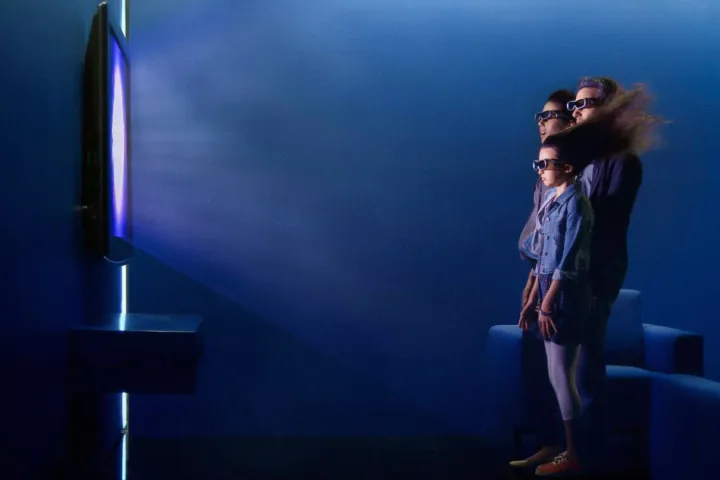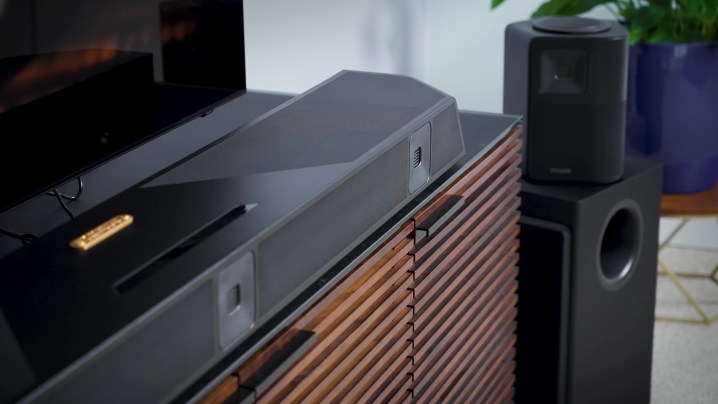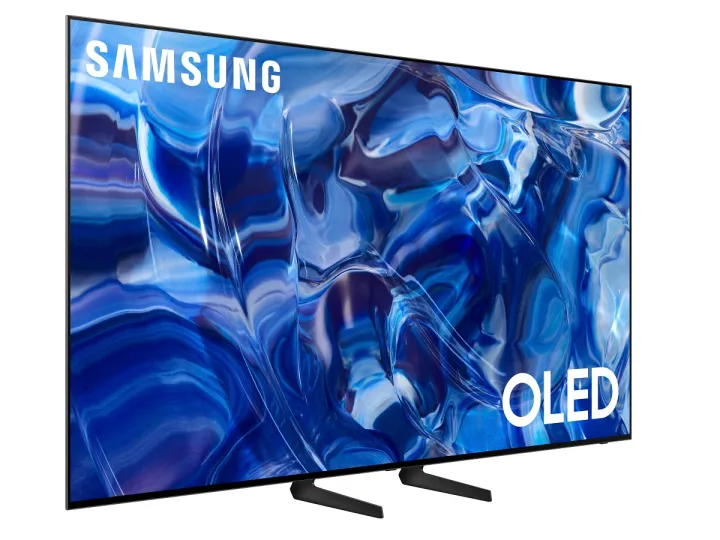In this installment of You Asked: TVs over the fireplace — yay or nay? Sonos versus Amazon, Google, and Apple speakers. And will 3D TVs ever make a comeback?
TVs over fireplaces
Kartik Khanna writes: I am buying an apartment where the only place to mount a TV is over the fireplace. I absolutely hate the idea of mounting an LG G3 over a fireplace, but I was wondering if you had any thoughts about the merits of mounting it with a Mantle Mount to avoid the inevitable neck strain.
Ooh, I have thoughts. And I’m happy to share them.
My stance on the whole TV-over-fireplace thing has evolved a bit over the years. I wrote an article about this years ago, and boy, did I get raked over the coals.
For those who don’t know, here are the three main reasons it’s a bad idea:
- It’s literally a pain in the neck. If you can’t get the TV down closer to eye level, you will end up tilting your chin up just enough that it can cause long-term discomfort or pain in the neck.
- The viewing angle of many LCD TVs is such that even if you angle the TV down toward where you sit, you will not get all the picture quality you paid for.
- If your fireplace and home are not properly ventilated, the heat and, sometimes, smoke can be bad for your TV, both in the short term and long term. Heat and electronics do not mix.
However, what experts like me often gloss over is that the space above the fireplace often is the only place you can fit a TV in the room due to its layout. I don’t know what modern home builds are looking like these days because it’s been a while since I went home shopping, but for decades, it was extremely common – especially with so-called “great room concepts” — to design the room so the only wall you can place the TV on has a fireplace in the middle of it. Other walls are too short, or you can’t place your seating across from any of the other spaces. So, many people don’t have a choice other than to have a dedicated TV room or just not have a TV in the main room. Those aren’t solutions.
Sometimes you need to mount your TV over the fireplace, and if that’s the case for you, I would highly recommend using an articulating, drop-down wall mount like this one from MantelMount that lets you bring the TV down closer to eye level and has a sensor built in to indicate if the TV is getting too hot. You can even get motorized versions of these mounts so that when you turn on your TV, it just drops down automatically. This way, you protect your neck, your eyes, and your investment.
MantelMount is not the only game in town. there are other manufacturers, like Sanus, for example, that make mounts like this. But I am a fan of MantelMount’s products and give them an enthusiastic thumbs up. We also recommend the MM700.
Sonos vs. Wi-Fi smart speakers

The second question today also comes from Kartik: Do you have any thoughts about the merits of adding in-ceiling Sonos speakers versus just spreading a few Wi-Fi-based speakers (say, HomePod Minis, which are less obtrusive) around the house? I really like the idea of the former, but products like Sonos in-ceiling speakers are expensive, plus a little unwieldy given the number of amps needed to spread the speakers around the house. As you can tell, I’m not a huge audiophile, but I admire the aesthetic advantage.
The first thing I want to call out is that Sonos in-ceiling speakers are just passive in-ceiling speakers. You could use any brand of quality in-ceiling speakers, and many of them would cost less than the Sonos or Sonance brand. Sonos in-ceiling speakers don’t have built-in amps or built-in Wi-Fi, which would make them so simple that you could just install them, run the Sonos app, and be done with it.
As you point out, you’ll have to have other Sonos equipment. The Sonos amps are very convenient because they bring Sonos simplicity to the amplification you need, resulting in fewer boxes to buy and install. But getting those Sonos amps ramps up the cost, too. This is true for any in-ceiling speaker setup. If you’re lucky, speaker wires for in-ceiling or in-wall speakers were run throughout the house and routed back to one central location when the house was built, so all you have to do is install the in-ceiling speakers where they need to go and then install the Sonos and amp stuff in the closet and get it all connected. That sounds simple, but it’s kind of involved, and frankly, I would recommend an installer do that work.
However, if you are trying to retrofit a house that didn’t have that CL3 in-wall-rated wire run when it was built, you definitely need an installer, and you’re looking at an even more expensive proposition.
Using Wi-Fi-enabled smart speakers may not be as stealthy as having in-ceiling or in-wall speakers, but they are a far less expensive way to get sound distributed throughout a home. As a bonus, they can actually sound a bit better in some cases. You could buy Sonos Era 100 speakers, or you could get any number of speakers that support Amazon Alexa or Google Home and still have a distributed audio system that works awesomely.
Where it gets trickier is integrating your TV sound with these independent smart speakers. If you want your speakers to not just handle music and podcasts and such, but also to play back what you’re watching on your TV, that’s going to be a lot easier with a Sonos setup than it will be with Amazon, Google, or Apple smart speakers, though it can be done.
Anyway, for cost and convenience’s sake, I recommend using practical smart speakers. If you are really into the idea of doing the in-ceiling thing, by all means, go for it. But I would recommend hiring a pro and being prepared to crack open your wallet a bit wider. It might be worth it to you if you’ll be in the home for a long time. But if you think you’re going move any time soon, don’t think you’re adding to the value of the home by doing an elaborate system. These built-in systems often go unused or are ripped out by new owners, according to installers I talk to.
3D TV

Tom Swift from Waterford, Ireland asks: With your vast connections in the digital world and, in particular, TVs, could you tell me if there are manufacturers anywhere in the world that still make 3D OLEDs? I heard they were great, but too expensive at the time for me to buy, but I think it would be my ultimate TV.
I’m afraid the bad news is this: As far as I’m aware, nobody is making a 3D OLED, or any other 3D TV, for that matter.
I understand that some folks really enjoyed their 3D TVs at home. In fact, I know of some folks who won’t upgrade their current TV because they’ll lose 3D functionality if they do. However, 3D was a massive failure for TV manufacturers. It was too expensive to do at high quality, or the cheaper, low-quality implementation disappointed viewers.
Back when I started reviewing TVs, you got active shutter glasses that would shut off your vision in one eye while passing light through the other eye — this caused flicker and dimmed the TV, a lot like the black frame insertion on TVs does now. It wasn’t great. Plus, those 3D glasses either ate batteries for breakfast or needed constant recharging.
The other issue with 3D was that the movie’s resolution was essentially cut in half because the TV had to show alternating frames to achieve the 3D effect.
Anyway, TV brands are aware that some die-hard 3D fans are out there, but they aren’t returning to the old ways. So until glasses-free 3D can be done on the cheap and produced at scale, I’m afraid we’ll have to reserve 3D as a treat we get at the cinema. I’m sorry I don’t have better news on that front, but if it is any consolation, you are far from being the first or only person to bring this up.
Speaker dropout

Scott Baker writes: My new Sony 77 A95L connected to a Nakamichi Dragon soundbar will intermittently switch back-and-forth from external speaker (Nakamichi) to internal TV speakers. Any way to fix this in the settings? There is no software “switch” in the sound settings menu to select “external only.” Is this a bug?
Yeah, Scott, that sucks, and I’m sorry for that frustrating situation. First off, in the A95L menu, if you select the Settings cog on the remote, then the Settings cog icon in the upper-right of the screen, then scroll down to audio output, you should be able to select either “TV speakers” or “audio system.”
If you have “audio system” selected and you are getting dropouts, it’s because the TV is seeing the audio system disappear. Now, is that the TV’s issue, or is it the Nakamichi’s issue? Or is it an HDMI cable issue? I would buy a high-quality, ultra-high-speed HDMI cable and eliminate it as a potential culprit because any signal issues due to the cable could cause the problem you’re describing. Nakamichi has told me that certain cables have caused issues when used with certain source components. For example, using a Zeskit cable apparently causes issues with a Sony TV, especially when a PlayStation 5 console is involved. I’ve also been told that Belkin’s ultra high-speed HDMI cable is best for use with an Apple TV.
Anyway, if you replace the cable with an ultra-high-speed cable as I suggest and it keeps happening, well, then, we need to figure out if this is a Sony A95L issue — and it could be because I’ve had some handshake problems with the TV. This reminds me: make sure your A95L is running the latest software update. That could also fix the problem.
But, it could also be that the Nakamichi is dropping its handshake as well, which would be an issue for Nakamichi to fix. Nakamich says it is gathering as much information as it can from customers and using that to build a database from which it can conduct further testing. Sadly, though, eARC and ARC are known to be buggy.
Samsung S89C

KevinB writes: I have a few questions about the Samsung 77-inch S89C. It seems to be an S90C, but is only sold at Best Buy. I really can’t find the difference between these TVs.
I’m so glad this question came in. I knew this would be an issue, and here it is.
Most tech journalists who cover TVs felt like the S89C didn’t make a ton of sense and, worse, would create a lot of confusion. So here’s the deal on the S89C.
The S89C is a QD-OLED TV that is virtually indistinguishable from the Samsung S90C. It has all the same hardware and features as the S90C. It’s just a Best Buy-exclusive model. If I had to guess, I would say that Samsung had to create a different model number and SKU so that Best Buy could discount the TV further than other retailers are allowed to do. But, again, that’s just an educated guess. Samsung has not provided any concrete information about the S89C other than to confirm its existence as a QD-OLED TV in its lineup that’s exclusive to Best Buy.
Editors’ Recommendations
Source link









